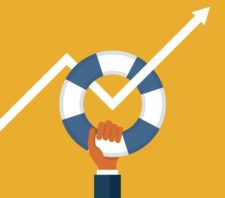 The old saying “fortune favors the bold” has been on my mind. In the majority of cases, when examining success, it stems from a bold belief and action. It took some getting out of your comfort zone, having some faith, and then letting the hard work and planning to payoff.
The old saying “fortune favors the bold” has been on my mind. In the majority of cases, when examining success, it stems from a bold belief and action. It took some getting out of your comfort zone, having some faith, and then letting the hard work and planning to payoff.
If something requires a bold action, then fear of failure is the other side of the equation. When starting a business, debt and losing everything are possibilities. If you’re going to be first to land on the moon, you’ll likely be on the brink of death a time or two.
One bold move that many people make, sometimes unknowingly, is having their nest egg in the stock market during retirement. Most people need to make this bold move, because they need the returns the market has historically provided for their portfolio retirement.
Some people are very aware of the tough times they’ll eventually experience in the market, ala 2000 and 2008. These two market environments severely tested the ability to stick with a plan. It’s tough when you watch your balance from top to bottom lose 30 percent or more. It’s even tougher when this occurs on a larger balance than you had in your early working years, coupled with the fact you aren’t saving anymore.
You will most likely be better off sticking through tough times in the market with bold action. Many factors play into this, but a well-designed plan makes this true far more often than not. The recovery and subsequent returns afterwards can be awe inspiring.
I’ve talked about these concepts in the past, but one thing made me more acutely aware of the feeling people go through during retirement. It involved running what is called Monte Carlo scenarios with an investment portfolio during retirement. You enter in basic variables such as the income needed to draw from the account, and then the computer runs 1000 random market environments.
The market doesn’t go up in a straight 7 percent line each year. Some years it’s down 20 percent, and other years it’s up 30 percent. This concept is called “sequence of return risk.” It means that while you could get an average of 7 percent return, the order in which you get that return is vitally important to your nest egg surviving your retirement.
Until recently, I couldn’t precisely see the path a nest egg takes during these trials. It would simply spit out a rate of success. Now I can look at your retirement portfolio sequence through 20 to 30 years in multiple market conditions. I was shocked by emotionally connecting with how it would feel if your portfolio saw those kinds of movements at the later stages of retirement. When your medical costs are inflating well above everything else, in conjunction with pulling income from the portfolio, it’s amazing to observe just how low the portfolio balance gets through the rough patches.
Many times, a portfolio will drop to a balance that would frighten the daylights out of retirees. The spectacular thing to observe is to watch the recovery of that balance as the market rebounds. Many times, it bounces back in dramatic fashion and carries the retiree through to the end of the plan.
Now, would you have been bold enough to stick with the plan? Those who bailed, and you can ask many who did during 2000 or 2008, severely damaged their long-term success. In many worst cases, people ran out of money by moving their money to safer pastures. People were forced to dramatically alter their lifestyle to make their money last. If instead you were bold enough, in most cases, things worked out really well. The returns after the rough patch drove balances higher to more comfortable levels. For those who panicked, would likely have moved aside with a lower balance.
Ask any succssful person to talk about their full story, and there is usually a story about the lean times. It was their bold moves and faith in their plan that got them through.
The main point I’m trying to make is that for the vast majority of Americans who haven’t saved well in excess of the safe amount to retire, it will require one to be bold in the face of declining markets. Even in successful plans, they can teeter close to the brink of failure a time or two, and yet turn out extremely well.
If you would like to see these tests performed on your portfolio, feel free to contact me for a consultation. I hope by being prepared for the inevitable, you’ll be more prepared to be bold in the face of fear.
(Past performance is no guarantee of future results. Advice is general in nature and not intended for specific siuations.)
